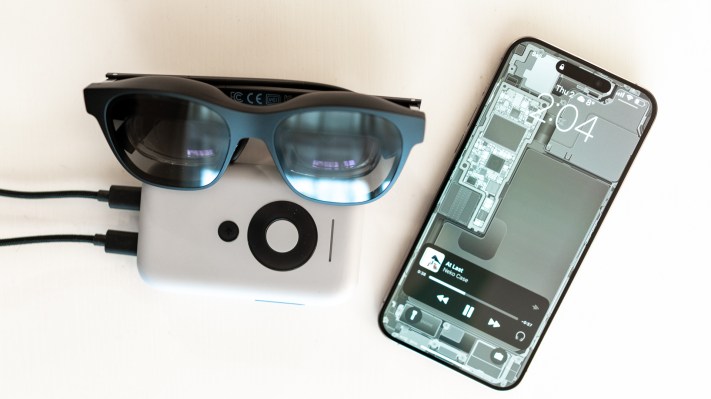iPhone 15 got USB-C, a great upgrade just for the sake of cable management sanity, but that also brought support for native video out. That means you can connect displays to the iPhone easily with a single cable and do fun stuff like output Netflix videos to your hotel TV, for instance — but it also means you can use a bourgeoning accessory category that actually adds a ton of utility and convenience to the device you have on you most often, particularly when traveling.
I’m talking about the bevy of so-called “augmented reality” glasses that are priced at between $300 and $500, and that are more accurately described as glasses with very nice, very small built-in projector screens. The pair I’ve been using most, and that I’ve very much enjoyed pairing with my iPhone 15 Pro, are the Xreal Air (the company has since introduced the Xreal Air 2, and the upgraded Xreal Air 2 Pro), which boast a 120Hz, 0.68-inch MicrOLED display that are bounced off a mirror onto the lenses, which allows you to see both the display as well as the world around you. If you want a more immersive viewing environment and true blacks, simply add the physical hood to the front of the glasses to block out all light transmission.
The Xreal Air don’t have their own power supply, and instead they’re powered by whatever devices you connect to them — just like many of the USB-C portable monitors available on the market currently. They work great out of the box with their included USB-C to USB-C cable and the iPhone 15 line, and you should instantly see your screen mirrored on the Air’s display once you plug them in. By default, it should just mirror your phone’s homescreen and apps, but for video streaming apps specifically that support video out, you’ll get a screen-filing landscape orientation video once you jump into streaming an actual show or movie.
It’s also a fantastic accessory for playing games, particularly when paired with the Backbone USB-C controller, for a much larger and more immersive view — and it’s honestly not bad for browsing the web with a minimalist setup that includes a paired Bluetooth keyboard. I’ve even used it to write some posts here and there while on a plane using our WordPress backend. It also supports adding your own prescription lenses via an included insert, and I ordered some with my prescription from HONSVR for about $50 shipped.
The Xreal Air experience can get better, too — once you add in the optional Xreal Beam accessory, you get the ability to fix your virtual display in space relative to your head position, which can cut down on any inner ear-related seasickness you might otherwise feel. The Xreal Beam has its own app platform — which is as yet underdeveloped, however — and also acts as a backup battery bank if you’re not using its onboard power for any augmented reality tasks. Plus, you can use it to connect up a range of devices, including game consoles like the Switch and PS5 for a very large virtual display that can scale as big as 300 inches.
To be clear, this the sleight-of-hand version of what Apple’s going to deliver with the Vision Pro: more parlor trick than paradigm shift. But at around a tenth of the cost, available right now, and with a bunch of the everyday features you’d want from a spatial computer you can actually carry with you everywhere, and a much lighter and more discreet form factor, it’s probably a better option for most people — even when the Vision Pro does arrive next year.
